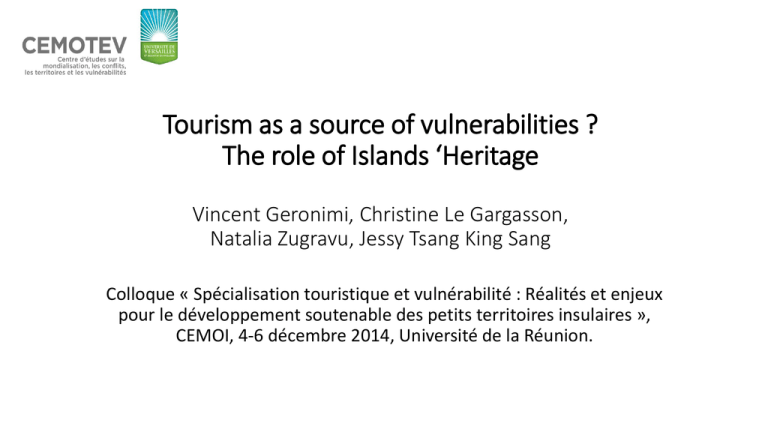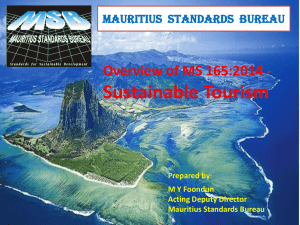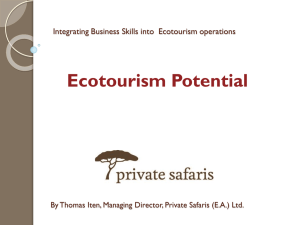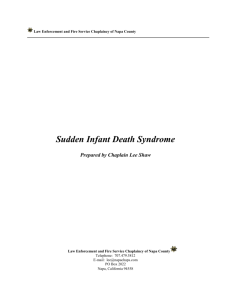Tourisme et soutenabilité : le rôle des patrimoines insulaires Vincent
advertisement

Tourism as a source of vulnerabilities ? The role of Islands ‘Heritage Vincent Geronimi, Christine Le Gargasson, Natalia Zugravu, Jessy Tsang King Sang Colloque « Spécialisation touristique et vulnérabilité : Réalités et enjeux pour le développement soutenable des petits territoires insulaires », CEMOI, 4-6 décembre 2014, Université de la Réunion. Introduction Under which conditions a tourism specialization can be sustainable for Small Island Economies ? • Ambiguous results on the connections between growth and tourism specialisation: • Engine of growth (Lanza & Pigliaru, 2000 ; Pablo-Romero & Molina, 2013), and more specifically for small islands economic development (Hampton & Jeyacheya, 2013 ; Seetanah, 2010)… • …Though with a decreasing marginal impact on economic development (Holzner, 2011 ; Adamou & Clerides, 2010). • Our own results exhibit a non-linear connection between tourism specialisation and vulnerability (Economic Vulnerability Index, EVI): • Tourism specialisation increases economic vulnerability using a large sample of countries. • We also find that for limited and strong tourism specialisation, tourism specialisation increases economic vulnerability, though intermediate tourism specialisation does not impact vulnerability, for SIDS and non-SIDS as well. Tourism contribution to Vulnerability lnK lnLabor Results from a panel regression with random effects lnVoice&Account lnOpen lnFDI lnEducation List of variables lnNatResRent EVI SIDS x lnNatResRent GDPcap K Retrospectif EVI according to the 2012 definition lnTourGDP GDP per capita (constant 2005 US$) [NY.GDP.PCAP.KD] Gross fixed capital formation (constant 2000 US$) (lnTourGDP)2 Labor force, total SIDS x (lnTourGDP)2 Voice&Account Voice and Accountability: Estimate (lnTourGDP)3 Open Trade (% of GDP) [NE.TRD.GNFS.ZS] SIDS x (lnTourGDP)3 FDI Foreign direct investment, net inflows (BoP, current US$) [BX.KLT.DINV.CD.WD] lnTourGDP x lnNatResRent Education Labor force with tertiary education (% of total) TourGDP (2) lnEVI only SIDS 0.025 (0.105) -0.096 (0.159) -0.897 (0.547) 0.012 (0.237) -0.001 (0.034) -0.289* (0.080) (3) lnEVI SIDS vs all -0.092* (0.030) 0.018 (0.035) -0.217* (0.077) 0.088+ (0.046) -0.016* (0.008) -0.070* (0.020) 0.214 + (0.127) -6.421 (4.453) -0.119 (0.087) 2.991 (2.094) 0.013 (0.019) -0.440 (0.317) 0.254 + (0.132) -2.833 (2.134) -0.247 * (0.117) 1.283 (1.008) 0.068 + (0.036) -0.215 (0.154) SIDS x lnTourGDP Labor NatResRent (1) lnEVI All -0.080* (0.030) -0.013 (0.031) -0.272* (0.074) 0.129* (0.044) -0.016* (0.008) -0.062* (0.019) SIDS x lnTourGDP x lnNatResRent SIDS total natural resources rents of gdp Tourism contribution to GDP_% share latitude Latitude in degrees SIDS =1 if SIDS, 0 - otherwise latitude _cons N r2_w r2_b r2_o -0.004* (0.002) 5.183* (0.532) 214.000 0.327 0.489 0.558 0.009 (0.006) 11.521* (3.662) 38.000 0.354 0.793 0.695 2.430+ (1.451) -0.004* (0.002) 5.355* (0.565) 214.000 0.355 0.531 0.603 (4) lnEVI SIDS vs all -0.056+ (0.030) -0.005 (0.040) -0.228* (0.067) 0.095+ (0.049) -0.015* (0.007) -0.044* (0.020) -0.025 (0.028) -0.536* (0.134) 0.006 (0.082) -1.066 * (0.214) -0.001 (0.015) 0.162 * (0.072) 3.094* (0.518) -0.003+ (0.002) 4.832* (0.628) 172.000 0.627 0.454 0.448 Introduction • Thus thresholds affect the relationship between tourism, growth and vulnerability • Considering vulnerability as a risk of non-sustainability, we propose here an analysis of these thresholds using a sustainability and total wealth approach (Hamilton 2006, Couharde et al.2010). • Two proposals: • Tourism impacts on growth are shaped by the kind of tourist services supplied. • For Small islands with high costs of production (mainly due to remoteness and limited size of markets), differentiated tourist services, based on heritage, are more likely to support weak and strong sustainability. Outline • Assets, weak and strong sustainability • The stakes of tourism for small islands sustainability • Tourist services: price competition vs heritage based differenciation • Conditions for the sustainability of tourism specialization. Sustainability definition: an asset based approach Weak and strong sustainability: New-Caledonia Weak Sustainability: • Genuine savings > 0 25% Epargne véritable en pourcentage du RNDB Tendance 22.5% Strong Sustainability: • Limited rural migration (Pestana, 2012) 20% 17.5% 15% 12.5% 10% 7.5% 1970 1975 1980 1985 1990 1995 2000 2005 • Preserved social and human capital (IAC, 2013) • Investment in economic and human capital more than compensates the depreciation of natural capital • The question of public transfers (géo-strategic capital ) ? Weak sustainability vs vulnerability: the heterogeneity of SIDS La diversité des petites économies insulaires (PEI), et des Small Islands Development States (SIDS) au regard des critères de soutenabilité et de vulnérabilité Rents, assets and total wealth • Following Hamilton (2006), the natural capital is valuated through rents (the difference between price and costs of production). • Intangible capital is the most important component of total wealth. It encompasses all components that are not directly computed: human capital, social capital, cultural capital,… • Each rents can be associated to a specific capital. Total Wealth composition, Average SIDS, 2012 Total Wealth composition, Nouvelle-Calédonie, 2006 15% 15% 15% 27% 58% 70% Capital naturel Capital intangible Capital physique Capital naturel Capital intangible Capital physique PEI: Assets, rents, risks and sustainability Assets Assets / Heritage Natural capital Natural capital Intangible capital Human and social capital Geo-strategic capital Rents Risks Exports of primary Fluctuation of commodities international prices Migrations Strong sustainability Simultaneaous degradation of different capitals: loss of human capital and social capital (e.g. rural emigration) Loss of social and human capital with decreasing remittances Closure of boundaries and "brain drain" Military, nuclear or Volte-face and Decreasing geo-strategic stakes strategic and decreasing transfers administrative Heritage based tourism and rents • Tourist services non differentiated, competition through price (sea/beach/sun): No rents and high costs (remotness,…) • Differentiated tourist services (heritage based, on specific assets), sources of rents Capital/ Heritage Specific intangible capital; Human, social and cultural Outstanding natural capital Rents Non sustainability risks Differentiation of tourist services: Prices higher than average costs of production Loss of differentiation: folklorisation, depreciation of social capital and traditionnal sectors (ex. Bali, île de Pâques) Over-crowding, environmental degradation Typology of SIDS’ tourist services: competition through prices or heritage mobilization Tourism specialization Average 1988-2013 Weak/ Limited (<20%) Medium/ Strong (>20%) Non differentiated Tourist Services <0 Limited tourism specialization « Price » evolution (Tourists expenditures per capita (19882013)) >0 Guinée Bissau, Guyane, Haïti, Papouasie Nouvelle-Guinée, Bahreïn, Seychelles, Singapour, Trinidad et Tobago Maurice, République dominicaine, Fidji, Jamaïque, Sao Tome et Principe, Belize, Cap-Vert Differentiated tourist services Tonga, Saint Kitts et Nevis, Antigua et Barbuda, Grenades, Bahamas, Vanuatu, Sainte Lucie, Dominique, Samoa, Saint Vincent, Maldives Perspectives • Tourism and connections between different kind of capital. Some preliminary results: • Concerning the impact of tourism on the GDP per capita • Substituability between tourism and economic / human capital for low level of the latters, complementarity for high level of human and economic capital • Complementarity between tourism and natural capital • For SIDS, complementarity between tourism and natural capital • Integration of heritage (e.g. Arezki et al., 2009, using World Heritage List) in the analysis of the connection between tourism and economic development. Measuring cultural capital. Thank you !











